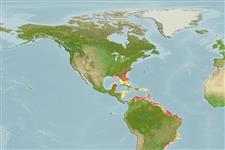>
Anguilliformes (Eels and morays) >
Ophichthidae (Snake eels) > Ophichthinae
Etymology: Ophichthus: Greek, ophis = serpent + Greek, ichthys = fish (Ref. 45335).
More on author: Kaup.
Environment: milieu / climate zone / depth range / distribution range
Écologie
marin démersal; profondeur 0 - 150 m (Ref. 5217), usually 5 - 40 m (Ref. 5217). Tropical; 37°N - 27°S, 90°W - 34°W
Western Atlantic: North Carolina, USA and northeast Gulf of Mexico to Brazil; absent from the Bahamas and most islands of the Caribbean.
Taille / Poids / Âge
Maturity: Lm ? range ? - ? cm
Max length : 81.0 cm TL mâle / non sexé; (Ref. 5217); common length : 60.0 cm TL mâle / non sexé; (Ref. 5217)
Occurs from shore to deep waters, but rare in shallow water (Ref. 7251). On the continental shelf of South America, this species is said to be common between 5 and 40 m depths (Ref. 5217).
Life cycle and mating behavior
Maturité | Reproduction | Frai | Œufs | Fécondité | Larves
Robins, C.R., R.M. Bailey, C.E. Bond, J.R. Brooker, E.A. Lachner, R.N. Lea and W.B. Scott, 1991. Common and scientific names of fishes from the United States and Canada. Am. Fish. Soc. Spec. Publ. (20):183 p. (Ref. 3814)
Statut dans la liste rouge de l'IUCN (Ref. 130435: Version 2024-1)
Menace pour l'homme
Reports of ciguatera poisoning (Ref. 30911)
Utilisations par l'homme
Pêcheries: sans intérêt
Outils
Articles particuliers
Télécharger en XML
Sources Internet
Estimates based on models
Preferred temperature (Ref.
123201): 22.5 - 28, mean 25.4 °C (based on 364 cells).
Phylogenetic diversity index (Ref.
82804): PD
50 = 0.5000 [Uniqueness, from 0.5 = low to 2.0 = high].
Bayesian length-weight: a=0.00091 (0.00039 - 0.00215), b=2.99 (2.79 - 3.19), in cm total length, based on LWR estimates for this (Sub)family-body shape (Ref.
93245).
Niveau trophique (Ref.
69278): 4.0 ±0.7 se; based on size and trophs of closest relatives
Résilience (Ref.
120179): Milieu, temps minimum de doublement de population : 1,4 à 4,4 années (Preliminary K or Fecundity.).
Fishing Vulnerability (Ref.
59153): Moderate to high vulnerability (52 of 100).
